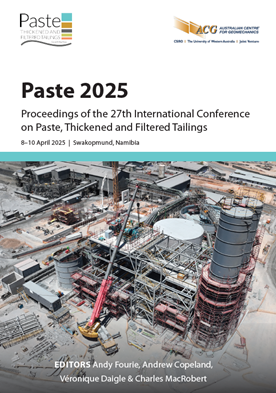Dry stacking of iron ore tailings: how Brazilian operations inspired filter press technology advances

|
Authors: Gerards, M; Panholzer, M |
DOI https://doi.org/10.36487/ACG_repo/2555_04
Cite As:
Gerards, M & Panholzer, M 2025, 'Dry stacking of iron ore tailings: how Brazilian operations inspired filter press technology advances', in AB Fourie, A Copeland, V Daigle & C MacRobert (eds), Paste 2025: Proceedings of the 27th International Conference on Paste, Thickened and Filtered Tailings, Australian Centre for Geomechanics, Perth, pp. 77-88, https://doi.org/10.36487/ACG_repo/2555_04
Abstract:
Following the 2019 Brumadinho dam collapse and the subsequent ban on upstream tailings dams in Brazil, local mining companies have shifted to alternative methods for tailings treatment. One such approach involves the dewatering of tailings, significantly reducing moisture content to produce a stackable material and recovering water for re-use in mining processes. This paper presents two case studies from major Brazilian iron ore producers Mineração Morro do Ipê and Itaminas, which each use filter press technology in treating 13,344 and 10,500 tonnes of dry iron ore tailings daily and recovering 9,700 and 8,800 m³ of water per day: overall, a successful application that reduces water consumption and generates optimised tailings handling. Building on insights from these case studies, international technology company ANDRITZ Group has developed an advanced filter press model that focuses on significant operational enhancements. This paper not only outlines the outcomes of the case studies but also examines how filter press operations at Mineração Morro do Ipê and Itaminas have influenced research and development efforts, particularly in the areas of filter plate handling and filter cloth replacement. In addition, the paper analyses the expected advances in reducing overall cycle times and increasing the throughput capacity of each filter unit, as well as the role of automation technology in further improving filtration performance. Beyond the case studies, this paper also explores the future trajectory of filtration technology and its potential to contribute to more efficient and sustainable mining operations.
Keywords: tailings management, filtration, dewatering, intelligent filter press, sustainability, automation, digitalisation, operational safety, process optimisation, efficiency in mining
References:
Columbia Climate School 2019, ‘Brumadinho Dam collapse: outlook and policy objectives’, State of the Planet: News from the Columbia Climate School, viewed 14 October 2024,
Darlington, S, Andreoni, M, Glanz, J, Bloch, M, Peçanha, S, Singhvi, A & Griggs, T 2019, ’A tidal wave of mud’, The New York Times, viewed 15 October 2024,
Gallas, D 2019, ‘Life after a devastating mining disaster’, BBC South America, viewed 14 October 2024,
Parente, C, Lino, S, Carvalho, G, Pzzochero, A, Azevedo-Silvia, C, Freitas, M ... Malm, O 2020, ‘First year after the Brumadinho tailings’ dam collapse: Spatial and seasonal variation of trace elements in sediments, fishes and macrophytes from the Paraopeba River, Brazil’, Environmental Research, vol. 193,
The Water Diplomat 2021, Brumadinho Mine Disaster: Vale Agrees $7 Billion USD Reparation Settlement, viewed 11 October 2024,
© Copyright 2025, Australian Centre for Geomechanics (ACG), The University of Western Australia. All rights reserved.
View copyright/legal information
Please direct any queries or error reports to repository-acg@uwa.edu.au
View copyright/legal information
Please direct any queries or error reports to repository-acg@uwa.edu.au
